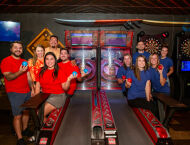Culture
 Kahina Haynes. Photo by Mackenzie Grant.
Kahina Haynes. Photo by Mackenzie Grant.
Kahina Haynes Advocates for Equitable Dance Opportunities at The Dance Institute of Washington
September 5, 2023 @ 10:00am
Haynes talks the dance scene right now, training at Dance Institute of Washington and what the dance community needs in this moment.
We spoke with 11 of D.C.’s performing arts professionals to learn more about how they set the scene. Check out the rest of the roundup here.
Kahina Haynes work as a dancer, teacher and executive director of the Dance Institute of Washington (DIW) has helped move the dance world forward in D.C. But meeting Haynes is enough to convince you that our most important muscles might be the ones in our ears. The native Washingtonian speaks passionately about how the DIW contributes to a changing field through equitable dance training and opportunities.
District Fray: How would you describe D.C.’s dance scene right now?
Haynes: It’s in motion. There’s a reclaiming of what we define as dance in D.C. and what the elements of our dance culture and ecosystem are. This is huge because for a long time our definition was what we’re not. Folks would say, “Well, we’re not…” followed by some city. Now, we’re defining ourselves in the affirmative.
What are some of those elements?
We’re seeing the incorporation of wellness and mental health, like with Beat Ya Feet. We’re highlighting process and methodology, even education. D.C. has historically been really product-centric, which contributed to systemic inequities. We were only getting to showcase the works that could afford a permanent place for their process. By acknowledging process and creativity and innovation, we’re opening the door for all kinds of artists. It’s already making the dance scene more robust and representative.
Where does DIW’s training come into this?
Our founder Fabian Barnes set out to solve a problem from his lived experience as a member of a significantly underrepresented population in the professional dance industry. When I got to DIW, my reaction was that this issue needs a system-driven solution. What are the factors resulting in this problem, and what factors would our training have to include to address those? And we didn’t guess. We talked with students. Scholarships address financial barriers, but what happens when a student doesn’t have a sense of belonging? Asking those questions is why our holistic model has a high success rate.
What does the dance community need right now?
There’s not currently a source of information that equitably represents everything that’s happening in dance right now in terms of journalism and critique. That’s really important because people talking about something and wanting to know what’s happening is how we assign currency and value.
Learn more about Dance Institute of Washington’s training programs and public events, including their “Community on 14th” incubator and annual “Spirit of Kwanzaa” performance here. On Instagram, follow Haynes @kahinahaynes and DIW @danceinstituteofwashington.
Want more insight on the best locals and guides to follow? Join the District Fray community for exclusive access to guides and recommendations. Become a member and support local journalism today.







